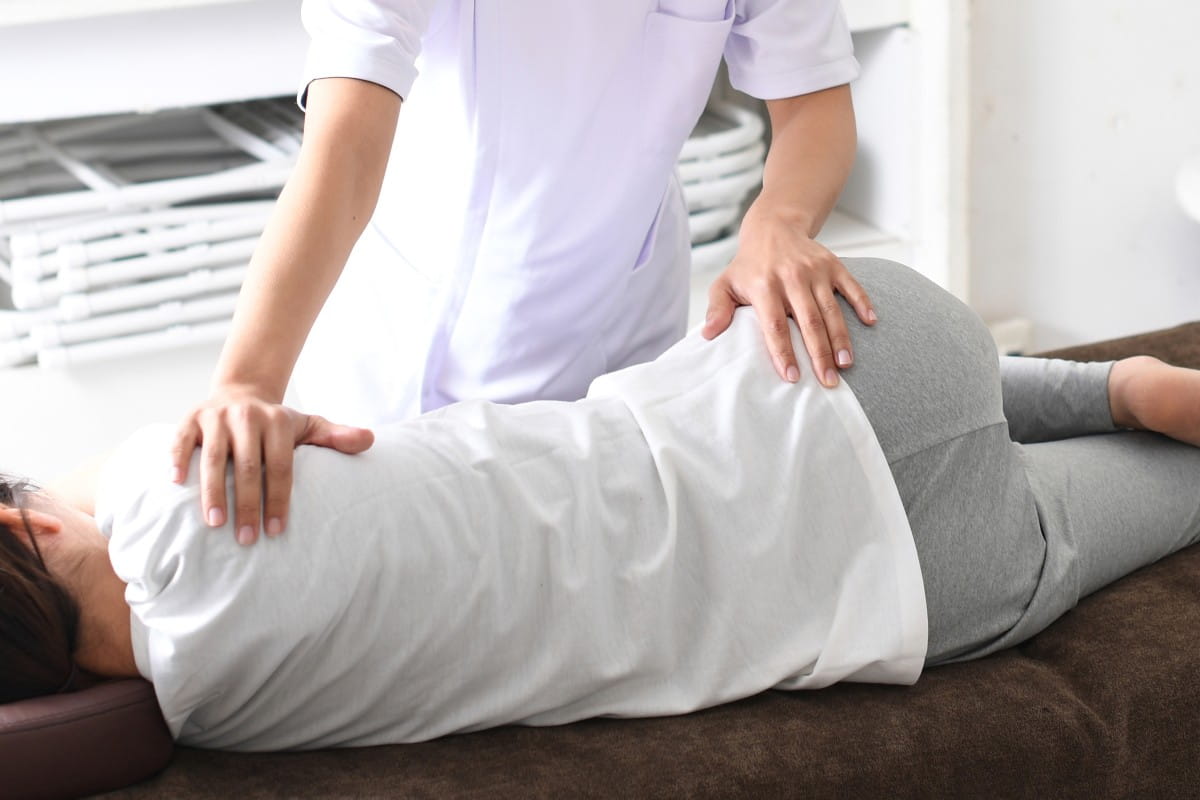Frankye Myers: From Riverside Health System. This is the Healthy you Podcast where we talk about a range of health-related topics focused on improving your physical and mental health. We chat with our providers, team members, patients and caregivers to learn more about how to maintain a healthy lifestyle and improve overall physical and mental health. So let's dive in to learn more about becoming a healthier you.
All righty. I'm really excited to have with me in the Healthy You studio today, Dr. Tompkins. Dr. Tompkins is a board-certified urogynecologist specializing in female pelvic medicine and reconstructive surgery with Riverside Urogynecology Specialists. That's a mouthful. Welcome, Dr. Tompkins.
Dr. Tompkins: Thank you very much, Frankye.
I'm excited to be here and talk about these really common but difficult problems. And to share some information on some of the treatment options available for patients as well.
Frankye Myers: Absolutely. So, we're going to be diving into breaking the silence and understanding treatment options for incontinence and pelvic prolapse, which we don't often talk about sometimes.
So welcome again. I'm Frankie Myers and I'm your host. A little bit about what we're going to be talking about impacts millions, but it's often, like I said, left unspoken in the urogynecology health arena. If you or someone you know has experienced incontinence or pelvic prolapse, you're not alone.
Many people hesitate to bring this up, as we mentioned, yet there are a variety of treatment options that can help you. All right. So first, tell me how you ended up in this field.
Dr. Tompkins: I didn't think going into med school I would be a urogynecologist, but I absolutely love it. There's really a huge need in this area.
So that brought me down to this area, to Williamsburg and Newport news. And there are a lot of things that can, a lot of things we have to help patients and patients really are hesitant to bring it up. So, it's really great to be able to make such a difference in patients lives. And it really, sometimes it allows patients to go out in public again.
Absolutely. Absolutely.
It's been a wonderful experience so far here. Enjoying my career.
Frankye Myers: Absolutely. Thank you for your commitment and thank you for what you do and sharing your time today. Dr. Tompkins let's start by setting the stage a little bit and just defining. What is urogynecology? What exactly is it?
What does it do? What is the specialty focus on? Like urogynecology over urology?
Dr. Tompkins: The main area of our specialty focus is female pelvic floor disorders. And so, the most common of those are urinary incontinence and pelvic prolapse. We also treat a lot of other conditions such as recurrent bladder infections, fecal incontinence gynecologic fistulas.
So, it's a wide variety of topics that we deal with and are especially in patients we can help. It is a combination of urology and gynecology; however it really is a unique specialty. Urogynecologists delve a little deeper into these problems and also, can offer some unique treatment options as well.
Frankye Myers: Okay. Okay. Very good. It's such an important area of care as a female in having. Just some knowledge of it just from my personal experience of childbirth and some things that happen later personally How do you think so many patients? Why do you think they hesitate to talk about it and to bring this issue up, especially incontinence or prolapse?
Dr. Tompkins: I'm glad you asked that question because That is the challenge sometimes Patients are I'm often hesitant or embarrassed to bring these topics up, especially urinary and fecal incontinence and other patients feel like maybe it's a normal part of aging or a lot of patients feel like maybe there's not a lot that can be done for it, but nothing could be further from the truth.
There are a tremendous number of treatment options that we have available. To help these patients both non-surgical and surgical minimally invasive options. It really can make a tremendous impact on a patient's quality of life. And please bring these issues up if you have them. I just for example, I've had, it's not uncommon for me to have a patient that comes into the office and says, I don't go out in public.
I'm, just afraid I'm going to wet myself. I stay at home all the time or I'm going to worry, I'm going to smell like urine. And we do 10-minute Botox injection or a 30 minute outpatient vaginal sling procedure. And they can go out with their friends for dinner pretty much the very next day without worrying about that.
And the other thing to keep in mind its, Pellet floor problems are also associated with other conditions. Depression, isolation, sexual dysfunction, vulvar skin problems. It can be a financial burden. I think I was reading about ten billion dollars are spent on pads and protection per year.
So really important to as a physician, our obligation is to ask patients, just because some aren't going to offer it voluntarily. So, ask patients about it and then just encourage them to openly discuss it and discuss treatment.
Frankye Myers: Okay. That's great. Great information. So, moving on into common pelvic floor disorders, let's talk about the conditions that you treat specifically and what are the most common pelvic floor disorders and how are they typically treated?
You did mention some are there other things that are done specifically?
Dr. Tompkins: Yeah, there are a lot of treatments for them, and I can go into kind of the most common problems that we deal with and what patients experience with them and then what the treatments may be. So, the most common conditions we deal with are urinary incontinence, pelvic prolapse.
And as far as I'll start with incontinence is leaking of urine. And so, there are two main types of incontinence. Stress incontinence is leaking with some activity such as coughing, sneezing, laughing, walking, jumping. That's anything that puts pressure on the bladder that pushes urine out and that's caused by a weakness in the support and muscles around the urethra, which is a tube coming out of the bladder.
And for that, we have a tremendous amount of conservative options pelvic floor exercises can help. Pelvic floor physical therapy, we have specialized physical therapists and nurses that use different techniques to strengthen the pelvic floor muscles, including electrical stimulation. Incontinence pessaries, which are little devices usually in the shape of a small ring with a little knob on it that pushes up on the urethra that, that a patient can insert vaginally.
Any of that can help. And then there are a lot, there are noninvasive surgical options as well. Urethral bulking is a 10-minute outpatient procedure, almost no recovery where we insert a little scope and do a little injection of a hydrogel that kind of partially blocks that urethra tube to prevent urine from coming out.
And then the gold standard for stress incontinence is a mid-urethral sling, which is a mesh tape that we put underneath the urethra to support it so that when a woman coughs or jumps, it keeps that urethra closed and that is, has an 85 percent cure rate then very quick recovery. So that's stress incontinence.
Urge incontinence is the more gotta go bladder. It's where a patient may feel the urge to go and rush to the bathroom or get up at night and not make it to the bathroom. For that type of incontinence, it is treated completely differently. It is treated with dietary changes can help. Limiting caffeine, artificial sweeteners can make a difference.
Pelvic floor physical therapy can help with that type of incontinence as well. There are medications, some of the newer ones now have very few side effects and work well. And then Botox injections have really revolutionized the treatment for overactive bladder and urge incontinence where we do little injections of Botox in the bladder muscle through a scope.
And it takes 10 minutes. It's an outpatient, basically no recovery with it. And that can last for six to 10 months. That's been very effective. And then for patients that have. more refractory problems or don't respond to other treatments. They may be an op candidate for something called neuromodulation, which I described to patients as a pacemaker of the bladder.
And
that
is a little implant that we put under the skin on the hip, and it sends a little electrical impulse to the nerves that go to the bladder to help the bladder relax. And those implants are very small. They're rechargeable. They're good for up to 20 years.
Frankye Myers: Okay. Wow.
Dr. Tompkins: And that's just incontinence. Wow.
And then getting a prolapse, it won't be as long with the prolapse options, but pelvic prolapse is basically a weakness in the supporting tissues and muscles of the pelvic floor. And that can cause symptoms for patients such as bulging pressure, feeling like something's falling out or protruding. If it gets too bad, it can make it difficult to empty the bladder or the rectum.
Frankye Myers: Right. And you can potentially see something protruding, right?
Dr. Tompkins: Exactly right.
Frankye Myers: You can progress, right?
Dr. Tompkins: Absolutely right. And that can be treated with pelvic therapy can help pessaries we use very frequently which just act as a brace and support the pelvic, the vaginal wall. And then there are a lot of different surgical options, minimally invasive, robotic surgeries with just small incisions, and then incisionless vaginal surgeries.
And
that can fix prolapse of the uterus, the bladder, the rectum, vaginal wall.
Frankye Myers: A lot of advancements. This is eye opening for me. I'm still on the sweeteners. The artificial sweeteners. And we're going to talk a little bit more about are there risk factors or lifestyle habits that could could, contribute to this, these conditions.
The sweeteners for me, are there things that you can do that before it's an issue that will prevent, are there exercises? I know after having children, and they said, do your Kegel exercises and build those muscles up. Are there things that can be, that you can do?
Dr. Tompkins: Absolutely. So obvious healthy lifestyle helps.
So good diet exercise prevents, not using tobacco staying normal weight. And then as you mentioned with the exercises, the pelvic floor exercises really can help. It's important that patients do it the right way. So those are exercises where you squeeze the muscles as if you're trying to stop a urine stream.
So usually what we recommend is squeezing those muscles as hard as you can for 10 seconds, relaxing for 10, squeezing for 10 squeezes two or three times every day. And you just want to make sure, patients want to make sure they don't. You can't do it the wrong way because it can do more harm than good.
You don't want to bear down. You don't want to hold your breath. Huh. And you don't want to use your stomach, your buttocks muscles. And sometimes it can be very difficult to do it correctly. So, we do something called Pelvic Floor Muscle Therapy where we actually can monitor a patient and determine whether they're squeezing the right muscles, the pelvic floor muscles.
Frankye Myers: Oh. Wow. Yeah. That's very helpful. Very helpful. Thank you.
Dr. Tompkins: Welcome.
Frankye Myers: All right. We're going to move into just some more treatment options. And one of the reasons we're here today is to let listeners know about the many treatment options available. And we've talked a lot about those as well. From a surgical spec standpoint, you've mentioned some, so rating those things from, least to, to, to most intensive, you want to talk a little bit about that?
Dr. Tompkins: Sure. If we, we have minimally invasive procedures that I mentioned, and then there are major surgeries for pelvic prolapse. The surgeries are going to be more of a major surgery. Because we have to do a reconstructive type of surgery. Now it's a lot different than it used to be. We don't usually have to make a big incision like in the olden days.
So, most of the time we do it robotically through the small incisions or vaginally with no incisions which makes it a much, much better recovery for patients. And then but for incontinence there are most of those procedures we do are very simple, quick procedures that work wonderfully and work right away or very quickly.
Frankye Myers: All right. It's good to hear that there are, solutions to these opportunities, no matter the severity or the symptoms and then, overcoming the stigma associated with that is a big piece as well. But hearing that there are solutions it's good to hear. For our viewers as well for many patients, that's the hardest part is starting the conversation.
And most often is this identified through primary care. So, we talk a lot about on the health view, about building that relationship and having a primary care physician who can, you can build a rapport and relationship with that can keep you on track with all of those disease preventative things that are age specific.
So, I don't know if that's where A lot of your referrals come from, but
Dr. Tompkins: they do. I definitely would encourage patients to talk to their primary care physician. First of all, it's our responsibility as doctors to ask patients these because most patients are hesitant to bring them up, but definitely talk to your primary care physician.
Your gynecologist is, would be very familiar with these. And then of course we're happy to see anybody in our office. I'm very fortunate in our office. I w I work with some wonderful, experienced nurses that really work hard to create a welcoming environment. And we really want to have patients be able to discuss these problems openly and feel comfortable doing so.
Frankye Myers: Yeah. I think that's the major piece to helping a patient overcome the stigma and feeling comfortable to your point is having the right people, that are compassionate and caring to support them and build in a trusting relationship. Would, wouldn't you say the same?
Dr. Tompkins: Absolutely. Yes.
Frankye Myers: Yes. Yes.
All right. Prevention and maintenance. Are there steps people can take to reduce their risk factors? We talked about that for pelvic floor issues or even maintain good pelvic floor health. And I just wanted to ask you, I know that are from child having children and large babies, how some of those things can lead to some of the things that.
Come up related to pelvic floor issues or bladder control opportunities. I don't know if that's a more high-risk population. And then I know as we get older with muscle, losing muscle tone.
Dr. Tompkins: So, you mentioned, two big risk factors having babies, which they're definitely worth it but it can start that injury of the pelvic floor, especially when they're large babies or you have episiotomies or tears.
And then there are other risk factors. Like you said, age, genetics has a big factor, is a big factor. If you have a, if a patient has a first degree relative with pelvic prolapse, they have a. two and a half times chance of having that. So that is, and obesity, tobacco, and then constant straining.
So, anyone who has chronic constipation should get that treated cause that over time just can put a lot of pressure on the pelvic floor.
Frankye Myers: That's great information.
Dr. Tompkins: But the most important thing too is everybody's at risk because 50 to 60 percent of adult women have urinary incontinence and 40 percent of women will have pelvic prolapse sometime in their life.
So, it's very common problems.
Frankye Myers: Very common.
But what's helpful is that you shared some really great information on prevention. So, starting some of those things or decrease the impact of also, there's a lot I noticed, even for myself and I don't know if others experience this, if you're doing something and you're excited, you tend to go to the bathroom more often.
Is that an excitable bladder or is that, would that be associated with stress?
Dr. Tompkins: It's a Both. It's an overactive bladder and it just means your bladder is contracting when you don't want it to. And there are certain things that can trigger it. If you're nervous, anxiety, nerves, caffeine, a lot of different things, dietary things.
Sometimes it happens without a trigger, but that's pretty common for that overactive bladder to be triggered from stress.
Frankye Myers: Okay.
That's very helpful. Thank you for all that you do and thank you for taking time out of your busy schedule to come and talk with us, and you're welcome to come back any time.
It's clear that there's hope there's treatments option available and there's support. Thank you so much.
Dr. Tompkins: I thank you very much for having me. I really appreciate it. It's been great to go over these problems that are very common, and hopefully get the word out there that there's a lot we can do for it.
Frankye Myers: Yeah, likewise, and to our viewers, if you're experiencing symptoms or have concerns about pelvic floor health, I encourage you to reach out to your healthcare provider. There are options out there for you and you deserve to feel your best. Thank you for tuning in to the Healthy You podcast. Be sure to subscribe to this episode and we hope this benefits and helps someone.
Look forward to seeing you next time.
Dr. Tompkins: Thank you.
Frankye Myers: Thank you for listening to this episode of Healthy You. We're so glad you were able to join us today and learn more about this topic. If you would like to explore more, go to riversideonline.com.



